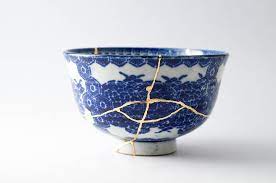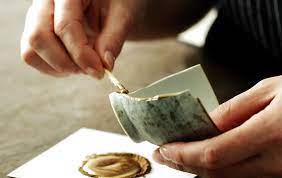Taking tips from the Japanese art of Kintsugi

Cherishing and Nurturing
We live in a society where we value all things new and shiny. A byproduct of the industrial revolution and an ode to capitalism, where we throw away anything broken and prefer to replace it with something unused. However, many ancient cultures have revered the practice of repairing, sustaining and reusing items, much longer than the habit of throwing them away. I recently stumbled upon the ancient art of Kintsugi. Kintsugi is the Japanese art of putting broken pottery pieces back together with gold — built on the idea that in embracing flaws and imperfections, you can create an even stronger, more beautiful piece of art.
Every break is unique and instead of repairing an item like new, the 400-year-old technique actually highlights the "scars" as a part of the design. I am fascinated by this concept and drawn to the idea that objects and relationships can be put back together, mended despite their flaws and made whole again. It speaks to me because it underlines the reality that we can find joy, beauty and fulfillment even in imperfection, in fact we need to highlight and celebrate it.
Finding relevance
The Kintsugi ( pronounced kint - sugi) technique repairs broken pottery with lacquer dusted or mixed with powdered gold, silver or in some instances even platinum. By highlighting the cracks instead of hiding them the repaired item is transformed into a luxurious item, displayed with pride. By embracing blemishes and ruptures, we can use this metaphor for healing ourselves and in the process create something more unique, resilient and alluring that will sustain itself and be stronger.
There are other ideologies that come into play when we examine and adopt this Japanese artistry. The first is “wabi-sabi” — the acceptance of impermanence and imperfection, an inevitable part of our world. Wabi-sabi encourages us to delight in irregularities and inconsistencies of the human hand, rather than striving for perfection. As I read these words, I feel like a mirror is being held up to me, waves of relief wash over me, knowing we should celebrate failure, mistakes and our scars. But the bigger lesson here is not to callously discard the item or the relationship but to strive to fix it, work on it or refashion it, even if it is just yourself, to recast in a new and bold mold.

Acceptance
To evolve into this avatar, compassion needs to be the underlying quality running like an underground river, smoothening our jagged edges. As we face the realities of our lives and imperfections that are a part of it, be they the objects, relationships or our unsuccessful actions - we become aware that acceptance is the balm which will heal everything. We must embrace our scars and our missteps, and live our daily life with dignity, grace and forgiving acceptance. Committing to a restorative process of continuous rebuilding and recreating elegant refinement.
Discarding is so easy, rebuilding requires work, tenacity and purpose. Adopting this demands us to favor joy and learning instead of regret and loss. This mental shift will be dramatic and the rewards will be even more amazing. I hope you will join me in this journey as we salvage and save, cherish and retrieve, forgive failure and commend every endeavor.
We are stronger together






Comentários